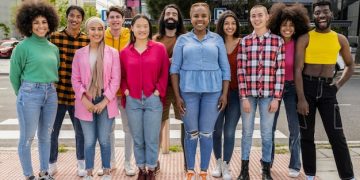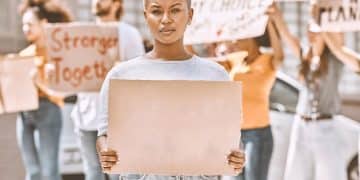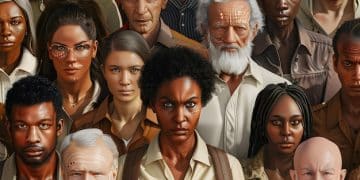Media Stereotypes: Promoting Accurate Portrayals for Social Justice
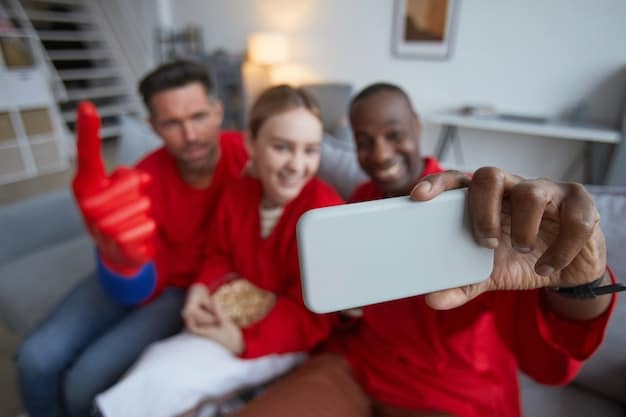
Media representation plays a significant role in shaping public perception and can perpetuate stereotypes, but media outlets can promote accurate portrayals by diversifying voices, challenging biases, and promoting nuanced stories.
The media holds immense power in shaping our understanding of the world and the people in it. When representations are skewed or limited, they can lead to the perpetuation of harmful exploring the role of media representation in perpetuating stereotypes: how can media outlets promote more accurate portrayals?. This article delves into how these stereotypes are formed and, more importantly, how media can actively combat them.
Understanding the Power of Media Representation
Media, in all its forms, acts as a mirror reflecting society and, simultaneously, a lens shaping our perceptions. From news reports and television shows to movies and social media, the stories we consume influence our understanding of different groups of people. Unfortunately, this influence can sometimes lead to the reinforcement of stereotypes.
When certain groups are consistently portrayed in specific, often negative, ways, it creates a skewed perception that can have far-reaching consequences. These consequences can range from prejudice and discrimination to systemic inequalities and a lack of empathy. Understanding this power is the first step toward fostering more responsible and accurate media practices.
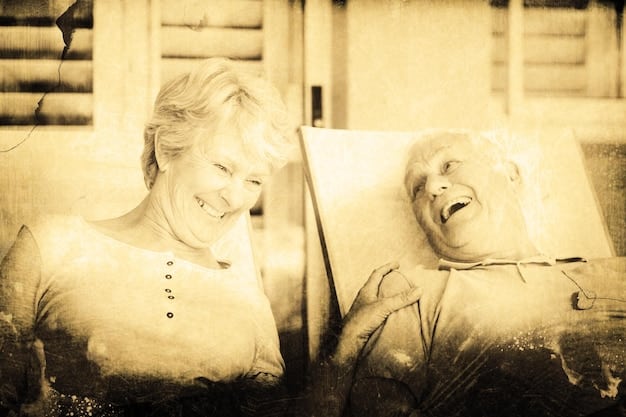
The Cycle of Stereotype Formation
Stereotypes are often formed through a multi-stage process. First, a limited or biased sample of a group is presented in the media. This limited representation leads to the creation of a simplified, often exaggerated, image. Over time, this image becomes ingrained in the public consciousness, making it difficult to see individuals within that group as complex and nuanced beings.
The media’s role in this cycle is crucial. Constant exposure to stereotypes reinforces them, making them seem natural and accepted. This, in turn, influences how individuals interact with members of the stereotyped group, perpetuating the cycle further.
The Impact of Media on Societal Perceptions
Media portrayals not only shape individual perceptions but also impact societal attitudes and policies. When stereotypes become deeply ingrained, they can influence everything from hiring practices to criminal justice outcomes. For example, if a particular ethnic group is consistently portrayed as criminal, it can lead to discriminatory policing practices and harsher sentencing.
Furthermore, negative stereotypes can have a detrimental effect on the self-esteem and well-being of members of the stereotyped group. Constant exposure to negative portrayals can lead to feelings of internalized oppression and a sense of not belonging.
- Reinforcement of Prejudice: Media stereotypes often reinforce existing prejudices and biases.
- Impact on Policy: These stereotypes can influence policy decisions, leading to discriminatory practices.
- Internalized Oppression: Negative portrayals can harm the self-esteem and well-being of those stereotyped.
The power of media representation is undeniable. It can shape our understanding of the world, influence societal attitudes, and impact the lives of individuals and communities. Recognizing this power is essential for promoting more accurate and responsible media practices.
Analyzing Common Media Stereotypes
Numerous stereotypes are consistently perpetuated in the media, often targeting specific groups based on race, gender, religion, sexual orientation, socio-economic status, and more. Recognizing these stereotypes is crucial to dismantling them.
Let’s delve into some common examples and analyze how they manifest in various forms of media.
Racial and Ethnic Stereotypes
Racial and ethnic stereotypes are among the most pervasive and damaging. These stereotypes often portray specific racial or ethnic groups in a simplified, negative light. For example, Black men are often stereotyped as criminals or athletes, while Asian individuals are often portrayed as overly intelligent but lacking in social skills.
These portrayals not only reinforce prejudice but also limit the opportunities and aspirations of individuals within these groups. They also fail to capture the diversity and complexity of these communities.
Gender Stereotypes
Gender stereotypes are equally prevalent, often portraying men and women in rigidly defined roles. Women are often stereotyped as emotional, nurturing, and submissive, while men are portrayed as rational, assertive, and dominant. These stereotypes limit the possibilities for both men and women, reinforcing traditional gender roles and expectations.
Furthermore, gender stereotypes can contribute to issues like sexism, gender inequality, and violence against women. They create a cultural climate where harmful behaviors are normalized and excused.
Socio-economic Stereotypes
Socio-economic stereotypes often portray individuals based on their economic status. People from lower socio-economic backgrounds are often stereotyped as uneducated, lazy, and criminal, while those from wealthier backgrounds are portrayed as entitled, out-of-touch, and corrupt.
These stereotypes perpetuate harmful myths about poverty and wealth, reinforcing systemic inequalities and limiting social mobility. They also fail to recognize the complex factors that contribute to poverty and wealth, such as historical injustices, lack of access to education and healthcare, and structural barriers.
- Asian Americans: Often portrayed as the “model minority,” masking socioeconomic diversity.
- Black Men: Frequently depicted with stereotypes of criminality or hyper-sexuality.
- Women: Consistently shown in stereotypical roles, such as the submissive housewife.
By analyzing these common media stereotypes, we can begin to understand their impact and work towards creating more accurate and nuanced portrayals.
Deconstructing the Effects of Stereotypical Media
The perpetuation of stereotypes in media can have a multitude of negative effects, influencing societal attitudes, personal identity, and intergroup relations. Understanding these effects is crucial to advocating for more responsible and ethical media practices.
These effects operate at multiple levels, from individual self-perception to systemic inequalities.
Impact on Self-Perception and Identity
When individuals are constantly exposed to negative stereotypes about their group, it can have a detrimental effect on their self-esteem and sense of identity. They may begin to internalize these stereotypes, believing them to be true and limiting their aspirations and potential. This phenomenon, known as “stereotype threat,” can lead to underperformance in academic and professional settings.
Furthermore, constant exposure to negative portrayals can lead to feelings of shame, anger, and resentment. It can also create a sense of alienation and isolation, making it difficult for individuals to connect with others and feel a sense of belonging.
Influence on Intergroup Relations
Stereotypes can also negatively impact intergroup relations, creating and reinforcing prejudice and discrimination. When people hold negative stereotypical beliefs about another group, they are more likely to treat them unfairly, engage in discriminatory behaviors, and support policies that disadvantage them.
Stereotypes can also lead to misunderstandings and miscommunications between groups. They create a filter through which people interpret each other’s actions and intentions, leading to inaccurate assumptions and biased judgments.
Perpetuation of Social Inequalities
The perpetuation of stereotypes in media can contribute to the maintenance of social inequalities. By reinforcing negative beliefs about certain groups, stereotypes can justify discriminatory practices and policies, making it more difficult for those groups to achieve equality and justice.
For example, if a particular group is consistently portrayed as lazy and unmotivated, it can be used to justify denying them access to education, employment, and other opportunities. This, in turn, reinforces the stereotype, creating a self-fulfilling prophecy.
- Limiting Opportunities: Stereotypes can hinder access to education, employment, and other opportunities.
- Reinforcing Prejudice: Stereotypes reinforce prejudices and discrimination against marginalized groups
- Shaping Biased Attitudes: Prejudicial media shapes individuals’ attitudes toward minority groups leading to widespread bias.
By deconstructing the effects of stereotypical media, we can better understand the importance of challenging these portrayals and promoting more accurate and nuanced representations.
Strategies for Promoting Accurate Portrayals
Combating stereotypes in media necessitates a multi-faceted approach involving media outlets, content creators, and audiences. By implementing specific strategies, media can promote more accurate and responsible portrayals.
Here are some key strategies that can be employed to challenge stereotypes and promote diversity in media representations.
Diversifying Voices and Perspectives
One of the most effective ways to combat stereotypes is to diversify the voices and perspectives represented in media. This means hiring more journalists, writers, directors, and producers from underrepresented groups. It also means creating platforms for these individuals to tell their own stories and share their unique perspectives.
When diverse voices are included in media, it leads to more authentic and nuanced portrayals of different communities. It also challenges the dominant narratives that often perpetuate stereotypes.
Challenging Biases and Assumptions
Media outlets should actively challenge their own biases and assumptions. This can be done through internal training programs, diversity audits, and consultations with experts on cultural sensitivity. It’s important to recognize that biases can be unconscious and unintentional, but they can still have a significant impact on how stories are told.
By challenging biases, media outlets can ensure that their reporting is fair, accurate, and respectful of all communities.
Promoting Nuanced Storytelling
Instead of relying on simplistic stereotypes, media should strive to tell more nuanced stories that capture the complexity and diversity of human experience. This means portraying individuals as multifaceted beings with their own unique strengths, weaknesses, and aspirations. It also means exploring the systemic factors that contribute to social problems, rather than simply blaming individuals or groups.
Nuanced storytelling can help to break down stereotypes and foster empathy and understanding between different groups.

- Training on Cultural Sensitivity: Equip media professionals with the skills to avoid biased reporting.
- Supporting Independent Media: Encourage new media initiatives that authentically represent marginalized groups.
- Encouraging Authentic Narratives: Empower individuals to tell their own stories through media platforms.
By implementing these strategies, media outlets can play a vital role in promoting more accurate and responsible portrayals of different groups and contributing to a more just and equitable society.
The Role of Media Literacy in Combating Stereotypes
Media literacy, the ability to critically analyze and evaluate media messages, plays a crucial role in combating stereotypes. By developing media literacy skills, individuals can become more aware of the biases and stereotypes present in media and resist their influence.
Media literacy provides individuals with the tools to deconstruct media messages and understand their underlying assumptions and values.
Developing Critical Thinking Skills
A key component of media literacy is the development of critical thinking skills. This involves questioning the sources of information, evaluating the evidence presented, and identifying potential biases. By developing these skills, individuals can become more discerning consumers of media, less likely to accept stereotypes at face value.
Critical thinking also involves considering alternative perspectives and challenging the dominant narratives presented in media.
Understanding Media Production Techniques
Media literacy also involves understanding the techniques used to produce media messages. This includes understanding how images, sounds, and editing can be used to create certain effects and influence audience perceptions. By understanding these techniques, individuals can become more aware of how stereotypes are constructed and reinforced in media.
For example, understanding how camera angles are used to portray certain subjects in a more powerful or vulnerable light can help individuals to deconstruct the messages being conveyed.
Promoting Media Literacy Education
Media literacy education should be integrated into school curricula and community programs. This can help to equip individuals of all ages with the skills they need to critically analyze and evaluate media messages. Media literacy education should also focus on promoting awareness of media bias and stereotypes and empowering individuals to create their own media messages that challenge these portrayals.
By promoting media literacy education, we can create a more informed and engaged citizenry that is less susceptible to the influence of stereotypes and biases.
- Promoting Skepticism: Encouraging questioning of media content.
- Enhancing Analytical Abilities: Developing capacity to break down media messages.
- Supporting Constructive Media Use: Teaching effective techniques for producing and consuming media.
In conclusion, media literacy is an essential tool for combating stereotypes and promoting more responsible and ethical media practices. By developing media literacy skills, individuals can become more aware of the biases and stereotypes present in media and resist their influence, ultimately contributing to a more just and equitable society.
The Future of Media Representation
The future of media representation hinges on a continued commitment to diversity, inclusion, and responsible storytelling. As technology evolves and new media platforms emerge, it’s essential that media outlets prioritize accurate and nuanced portrayals of different groups.
The media landscape is constantly changing, and it’s important to anticipate the challenges and opportunities that lie ahead.
Embracing Technological Advances
Technological advances, such as artificial intelligence and virtual reality, have the potential to both perpetuate and combat stereotypes. It’s crucial that these technologies are developed and used in a way that promotes diversity and inclusion. For example, AI algorithms should be trained on diverse datasets to avoid perpetuating biases. Virtual reality can be used to create immersive experiences that promote empathy and understanding between different groups.
However, it’s also important to be aware of the potential risks of these technologies, such as the creation of deepfakes and the spread of misinformation.
Elevating Marginalized Voices
In the future, it will be increasingly important to elevate the voices of marginalized groups. This means creating platforms for these groups to share their stories and perspectives, and ensuring that their voices are heard in mainstream media. It also means challenging the traditional gatekeepers of media and creating more opportunities for diverse talent to enter the industry.
By elevating marginalized voices, we can create a more inclusive and equitable media landscape that accurately reflects the diversity of society.
Fostering Global Collaboration
Combatting stereotypes is a global challenge that requires collaboration between media outlets, content creators, and audiences around the world. By sharing best practices, developing common standards, and supporting international initiatives, we can work together to promote more accurate and responsible media representations.
Global collaboration can also help to challenge Western-centric narratives and promote a more diverse and nuanced understanding of different cultures and societies.
- Supporting Diverse Narratives: Promoting voices and stories of traditionally excluded groups.
- Employing Technology Ethically: Using advancements to combat stereotypes and misinformation.
- Educating Globally: Implementing worldwide media literacy drives.
In conclusion, the future of media representation depends on our collective commitment to diversity, inclusion, and responsible storytelling. By embracing technological advances, elevating marginalized voices, and fostering global collaboration, we can create a media landscape that promotes understanding, empathy, and social justice.
| Key Point | Brief Description |
|---|---|
| 📢 Media Power | Media shapes perceptions; skewed representations reinforce stereotypes. |
| 🎭 Common Stereotypes | Racial, gender, and socioeconomic stereotypes are pervasive in media. |
| 💪 Promoting Accuracy | Diversify voices, challenge biases, and tell nuanced stories for accurate portrayals. |
| 📚 Media Literacy | Critical analysis of media builds awareness and combats stereotypical influence. |
Frequently Asked Questions
▼
Media significantly shapes public perception by selecting, framing, and disseminating information, which influences how people understand and interpret events, issues, and social groups, leading to potential biases and stereotypes.
▼
Media outlets can diversify content by including a broader range of voices, stories, and perspectives from underrepresented communities, ensuring that their narratives are accurately and respectfully portrayed to challenge stereotypes.
▼
Stereotype threat is the risk of confirming negative stereotypes linked to one’s group, leading to anxiety and decreased performance in relevant contexts, and affecting self-esteem and opportunities for advancement.
▼
Common gender stereotypes in media include portraying women as emotional and submissive and men as assertive and dominant. These limited and often false portrayals can reinforce gender inequality in society.
▼
Media literacy is crucial for combating stereotypes because it equips individuals with critical thinking skills necessary to analyze and deconstruct media messages, recognize biases and stereotypes, and promote more informed and responsible media consumption.
Conclusion
In conclusion, media has a profound impact on society’s perceptions and behaviors. To combat stereotypes and promote social justice, media outlets, content creators, and audiences must actively challenge biases, diversify narratives, and cultivate media literacy. By collectively fostering more accurate and empathetic portrayals, we can build a more inclusive and equitable world.
